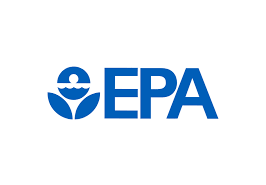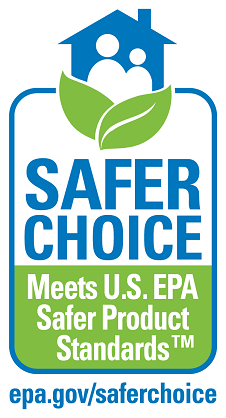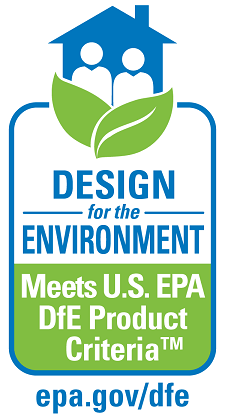
After consideration of public comments to the Safer Choice and Design for the Environment (DfE) Standard (88 FR 78017, November 14, 2023 (FRL-115180-01)), the U.S. Environmental Protection Agency (EPA) has issued the final Standard that includes updates on the criteria that products and their ingredients must meet to qualify for its voluntary Safer Choice and Design for the Environment (DfE) standard.
What Changes Were Made to the Final Updated EPA Safer Choice Program Standard?
Changes implemented into the final updated Standard included clarifying language and:
- Updated safer packaging criteria that will ensure primary packaging does not include any intentionally added PFAS or other chemicals of concern.
- A new certification program for cleaning service providers that use Safer Choice- and DfE-certified products. The program will help protect workers that use cleaning products as well as the people who live or work in the spaces they clean.
- Strengthened criteria that pet care products must meet to ensure they use only the safest possible ingredients for humans, pets and the environment.
- Strengthened sustainable packaging requirements for all Safer Choice-certified products to use post-consumer recycled content and be recyclable, or be reusable.
- Updated criteria for wipe products to ensure certified wipes contain “Do Not Flush” language to help reduce damage to wastewater treatment systems.
- New, optional energy efficiency or use reduction criteria to encourage companies to use less water, use renewable energy and improve energy efficiency.
Who is Affected by the Updates to the Safer Choice and DfE Standard?
Product manufacturers who participate in or apply for certification under the Safer Choice or DfE programs and use the programs’ label or logo on their products. Manufacturers must disclose “the full composition of all intentionally added ingredients” for product formulation evaluation, including disclosure by secondary and tertiary ingredient manufacturers, and known residuals.
Performance testing requirements are product-class specific. Manufacturers of window/glass cleaners, all-purpose cleaners, and other cleaning products (tub/tile, degreasers, hand dish soaps) must follow specific criteria for performance testing to confirm that the products “perform comparably to a conventional, nationally recognized product in its class and at equivalent product-specific use directions”.
The updated Standard includes additional requirements for verification that qualified products are being manufactured using approved ingredients through third-party desk audits and on-site audits.
Customers, institutional purchasers, retailers, and distributors of Safer Choice or DfE-certified products who use the label or logo to identify products that have met the EPA’s safer-product criteria will have more clarity of ingredient contents by product manufacturers. To enhance public awareness of ingredients that meet a high standard for human health and environment in DfE-certified products, the EPA is requiring manufactures to provide additional transparency through disclosure of all intentionally added ingredients and provide information on product labels, on the manufacturer website, or toll-free number.
The North American Industrial Classification System (NAICS) codes that may be affected include (but not limited to):
- Other Basic Inorganic Chemical Manufacturing (NAICS code 325180);
- All Other Basic Organic Chemical Manufacturing (Primary) (NAICS code 325199);
- Pesticide and Other Agricultural Manufacturing (NAICS code 325320);
- Paint and Coating Manufacturing (NAICS code 325510);
- Adhesive Manufacturing (NAICS code 325520);
- Soap and Other Detergent Manufacturing (NAICS code 325611);
- Polish and Other Sanitation Good Manufacturing (NAICS code 325612);
- Surface Active Agent Manufacturing (Primary) (NAICS code 325613);
- All Other Miscellaneous Chemical Product and Preparation Manufacturing (NAICS code 325998)
What is the EPA Safer Choice Program?

Developed in 1997, the EPA’s Safer Choice program (formally known as the Design for the Environment (DfE) Product Labeling Program) helps consumers, businesses, and purchasers find products that perform and contain ingredients that are safer for human health and the environment by certifying products containing ingredients that have met the program’s specific human health and environmental toxicological criteria, including carcinogenicity, reproductive/developmental toxicity, toxicity to aquatic life, and persistence in the environment. The Safer Choice program certification represents a high level of achievement in formulating products that are safer for people and the environment.
Before a product can carry the Safer Choice label, a workgroup of EPA scientists reviews all chemical ingredients, regardless of their percentage in the product. Every ingredient must meet the strict safety criteria for both human health and the environment, including carcinogenicity, reproductive/developmental toxicity, toxicity to aquatic life, and persistence in the environment.
The Safer Choice program allows companies to use its label on certified products that contain safer ingredients and perform, as determined by expert evaluation. For consumers and purchasers for schools and office buildings, the Safer Choice program makes it easier to find cleaners, detergents and other products made with safer chemical ingredients.

What is the EPA Design for the Environment (DfE) Program?
The DfE is a program that helps consumers and commercial buyers identify antimicrobial products (disinfectants) that meet the health and safety standards for public health and the environment by adhering to the normal pesticide registration process required by the Federal Insecticide, Fungicide and Rodenticide Act (FIFRA) as well as other EPA DfE criteria.
Contact RHP Risk Management
RHP Risk Management helps clients navigate the uncertainties associated with environmental, occupational, and consumer goods hazards and risks. RHP’s Certified Industrial Hygienists assist with development and updates to an employer’s hazard communication program, chemical inventory document management, and hazard communication training to ensure regulatory compliance. Additionally, RHP scientists can assist companies with navigating the requirements for products to qualify for the Safer Choice and Design for the Environment (DfE) standard including the evaluation of chemicals intentionally added or unintentionally discovered within the product such as PFAS.
For more information, contact Jacob Persky, MPH, CIH, Ben Heckman, MPH, CIH, Ashish Jachak, PhD,or Frank Pagone, PhD, CIH and visit rhprisk.com to learn more.
